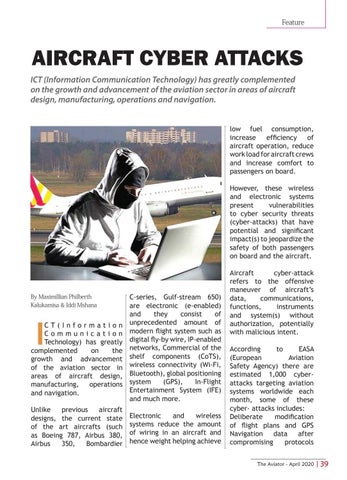Feature
AIRCRAFT CYBER ATTACKS ICT (Information Communication Technology) has greatly complemented on the growth and advancement of the aviation sector in areas of aircraft design, manufacturing, operations and navigation. low fuel consumption, increase efficiency of aircraft operation, reduce work load for aircraft crews and increase comfort to passengers on board. However, these wireless and electronic systems present vulnerabilities to cyber security threats (cyber-attacks) that have potential and significant impact(s) to jeopardize the safety of both passengers on board and the aircraft.
C-series, Gulf-stream 650) are electronic (e-enabled) and they consist of C T ( I n f o r m a t i o n unprecedented amount of C o m m u n i c a t i o n modern flight system such as Technology) has greatly digital fly-by wire, IP-enabled complemented on the networks, Commercial of the growth and advancement shelf components (CoTS), of the aviation sector in wireless connectivity (Wi-Fi, areas of aircraft design, Bluetooth), global positioning (GPS), In-Flight manufacturing, operations system Entertainment System (IFE) and navigation. and much more.
By Maximillian Philberth Kalukamisa & Iddi Mshana
I
Unlike previous aircraft designs, the current state of the art aircrafts (such as Boeing 787, Airbus 380, Airbus 350, Bombardier
Electronic and wireless systems reduce the amount of wiring in an aircraft and hence weight helping achieve
Aircraft cyber-attack refers to the offensive maneuver of aircraft’s data, communications, functions, instruments and system(s) without authorization, potentially with malicious intent. According to EASA (European Aviation Safety Agency) there are estimated 1,000 cyberattacks targeting aviation systems worldwide each month, some of these cyber- attacks includes: Deliberate modification of flight plans and GPS Navigation data after compromising protocols The Aviator - April 2020
39











